Overcoming Talent Challenges on the Road Ahead
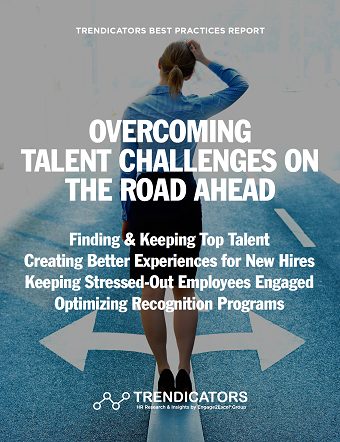
Introduction
At our November meeting of the Trendicators Advisory Board, we asked contributors for one word to characterize the past year and one word to describe their outlook for 2023. Here’s what they shared:
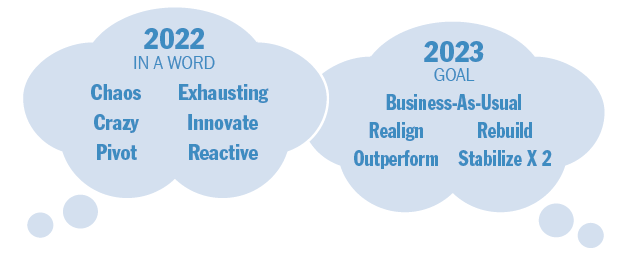
The past year has indeed been challenging with rising inflation, wage growth, talent shortages, global instability and supply chain disruption. While all these concerns are expected to continue next year, our advisory board members are optimistic that 2023 will be a year of recovery.
In this report, Engage2Excel subject matter experts share insights on trends and advise how to optimize recruiting, onboarding, employee engagement and employee recognition programs.
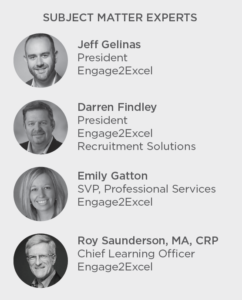
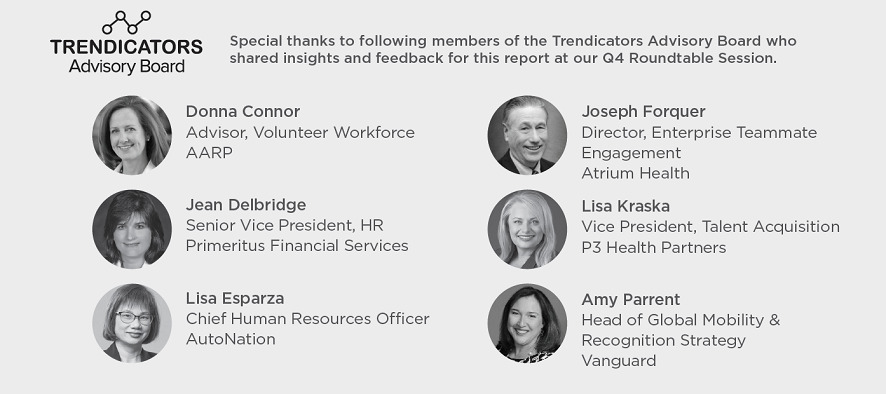
Trendicators is the research division of the E2E group of companies, leading providers of engaging career and consumer experiences. Trendicators provides original HR research, along with reports on insights and best practices from industry leaders and experts.
Download
 hbspt.cta.load(123973, '98ea4d07-59f6-47fe-bd1f-2c33fd9dbcbd', {"useNewLoader":"true","region":"na1"});
hbspt.cta.load(123973, '98ea4d07-59f6-47fe-bd1f-2c33fd9dbcbd', {"useNewLoader":"true","region":"na1"});
Finding & Keeping Top Talent
Darren Findley, President of Engage2Excel Recruitment Solutions, has a unique perspective on today’s job market based on three decades of recruiting experience across all major industry sectors. In his report to the Trendicators Advisory Board, he shared the following key statistics:
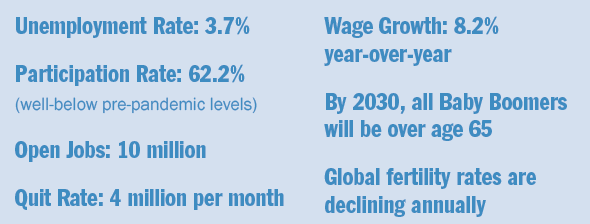
Demographics Over Economics: As a result of these converging factors, Darren has recently changed his perspective, believing that demographics will replace economics as the dominant force driving labor market trends. Understanding and responding to the unique needs and interests of diverse demographic segments will be essential for attracting and retaining top talent.
Technology Challenges: HR leaders report that their top technology challenges include:
- Siloed HR systems
- Data gaps and poor reporting
- Inability to make quick, informed decisions
- Subpar candidate and employee experiences
Record Investment in HR Tech: There was a 9% increase in spending on HR technology with talent management—including recruiting tools—at the top of the spending list. While tech stocks have taken a beating this year overall, HR tech stocks have outperformed the market over the past several years. With a record of 400 exhibitors at the 2022 HR Tech Conference, there is no shortage of SaaS solutions to today’s pressing HR challenges.
Experience Matters Most: Organizations that fare the best in today’s talent war must focus on and improve experiences for candidates and employees. Listening and responding to the needs and desires of candidates, employees and gig workers are the keys to building long-lasting relationships.
Technology-Enabled Engagement: HR tech stacks are expanding to include everything from chatbots, texting features, video job previews, video interviews, TikTok job previews and even TikTok resumes. Eventually, sourcing, candidate generation, interviewing and hiring will be part of an analytics-enabled talent ecosystem that includes onboarding, learning, skill taxonomies and performance management.
Challenges for Hiring Managers: Technology is important, but hiring managers are linchpins in improving hiring effectiveness. Our Trendicators 2022 Job Seeker Survey Report revealed that experiencing recognition in the hiring process was the single most important influence on a candidate’s job offer acceptance. Additionally, 39% of candidates said that a positive experience with the hiring manager was either “important” or “very important.” However, fewer than 5% of U.S. hiring managers have even one hour of professional interviewing training¹.
Optimizing Hiring Outcomes: To help hiring managers become more effective, Darren recommends training in the following areas:
- Behavioral interviewing
- Demonstrating recognition, appreciation and respect
- Enunciating your Employer Value Proposition (EVP) and competitive differentiation
- Identifying opportunities for career growth and advancement
1. https://huntscanlon.com/lack-of-interview-skills-fueling-post-pandemic-hiring-crunch/
Download
 hbspt.cta.load(123973, '98ea4d07-59f6-47fe-bd1f-2c33fd9dbcbd', {"useNewLoader":"true","region":"na1"});
hbspt.cta.load(123973, '98ea4d07-59f6-47fe-bd1f-2c33fd9dbcbd', {"useNewLoader":"true","region":"na1"});
Creating Better Experiences for New Hires
Darren Findley knows that in the post-pandemic hiring environment, effective preboarding and onboarding programs play a vital role in reducing the risks of early attrition and acceptance of competing job offers. In his presentation to the advisory board, he discussed why creating positive experiences for new employees is more important than ever, sharing insights into the technology landscape and improving program effectiveness.
Preboarding Vs. Onboarding: Preboarding begins the moment a job offer is accepted, whereas onboarding begins on the first day of employment.
First Experiences Influence Retention: Trendicators 2022 survey research indicates that 74% of employees believe their first day onboarding experience affects their decision to stay more than a month, a 12-percentage-point increase over 2019 survey results. Also, 72% of respondents said that their total onboarding experience would affect their decision to stay more than a year, also up 12 percentage points from 2019.
Key Onboarding Technology Capabilities: Onboarding software is available from large HCM system providers, talent acquisition platforms and specialized onboarding software platforms. Key features include:
- User-friendly interface
- Mobile optimization
- Workflow automation
- Assessment & survey capabilities
- Social capabilities
- Multi-user access & accountability
- Goal & deadline setting & tracking
- Analytics & reporting
Many providers offer AI-enabled capabilities for automating mundane tasks, providing real-time feedback through conversational chatbots and accelerating document exchange. While these capabilities will become more prevalent over time, HR data privacy is also a massive challenge in deploying AI. Employee data must be protected, and proper governance guidelines must be established for administering AI-driven HR interventions.
The Importance of Human Interaction: Darren cautioned that in addition to finding the right technology partner, organizations of all sizes must understand that the interpersonal experiences of new hires profoundly influence retention. He shared the following recommendations for improving preboarding and onboarding program effectiveness:
- Invite new hires to an internal social community upon offer acceptance
- Let teammates know that someone new is starting to encourage early social connections
- Establish a buddy system or mentoring program along with a well-organized onboarding plan for each new hire to reduce anxieties and help individuals understand what to expect and when
- Send a welcome package to all new hires immediately following offer acceptance
Case Study Results: Recently, Darren presented a case study at the 2022 CandE Awards & TalentNet Live Conference documenting the business impact of creating better experiences for 3,000 new hires over a 2.5-year period. These benefits included a 67% increase in the first day show rate and a 42% decrease in the first 90-day turnover rate.
Download
 hbspt.cta.load(123973, '98ea4d07-59f6-47fe-bd1f-2c33fd9dbcbd', {"useNewLoader":"true","region":"na1"});
hbspt.cta.load(123973, '98ea4d07-59f6-47fe-bd1f-2c33fd9dbcbd', {"useNewLoader":"true","region":"na1"});
Keeping Stressed-Out Teammates Engaged
Roy Saunderson, Engage2Excel’s Chief Learning Officer, brings over 26 years of specialized knowledge and work experience to the field of employee recognition. In his report to the advisory board, Roy focused on the need to humanize recognition programs by finding new ways to make recognition more personal and meaningful.
Completing Personal Profiles: A fundamental requirement for effective recognition is understanding how individual employees prefer to be recognized. Approximately 75% of all employees appreciate public recognition, whereas 25% prefer private acknowledgment. Roy believes that the best way to improve profile completion and personalization is for managers and leaders to include personal preference interviews in one-on-one meetings with direct reports. Going online together to do this offers an opportunity to discuss the importance of the organization’s recognition programs and helps managers get to know an individual’s interests and hobbies as well as how and for what they want to be recognized.
Peer-to-Peer Recognition: Employees who receive frequent recognition and appreciation from the people they work with are more likely to be productive, have heightened self-esteem and form deeper connections with their team members. The effectiveness of peer recognition is improved by teaching people how to express recognition in a variety of ways. Throughout his career, Roy has been on a mission to dispose of phrases such as “good job” and “well done” in the expression of recognition, as these phrases fail to acknowledge the action or behavior that merits recognition. Roy emphasizes the need to teach people to identify the action that merits recognition and be specific about the impact of that action on other individuals, a team goal or an organizational objective.
Helping Managers Become More Effective at Recognition: Gartner forecasts that the pace of employee turnover will increase by 50–75% compared to previously experienced turnover rates in companies. Unless efforts are refocused on retention, managers will be unable to drive performance and affect change. Leaders need to take action to enable their managers to keep their talent while still being able to deliver on results.
Our 2022 Trendicators Job Seeker Survey Report showed that, for the first time since 2019, the top reason given by all candidates for their willingness to seek employment elsewhere is not compensation but rather the failure of their employer to demonstrate recognition, respect and appreciation. To address retention challenges, managers need support and actionable insights concerning how to become more effective at delivering more frequent and meaningful recognition.
Manager Analytics: Together with Dr. Charles Scherbaum, Engage2Excel’s Chief Analytics Officer, Roy developed a tool for determining a recognition quotient, or RQ score, to evaluate how individual managers are using recognition programs and to assess employee perceptions of their managers’ effectiveness at giving recognition. Together, these two scores enable predictive and prescriptive analytics that provide leadership with an objective measure of how individual managers are performing along with targeted micro-learning feedback modules with which managers can enhance their recognition skills. This solution has helped clients achieve significant improvements in performance across business functions and assisted managers in developing the skills that increase their appreciation ratings.
Recognition platforms have made substantial progress over the past decade. The current challenge for HR leaders is to help employees and managers better utilize these platforms to communicate more meaningful and personal recognition.
Download
 hbspt.cta.load(123973, '98ea4d07-59f6-47fe-bd1f-2c33fd9dbcbd', {"useNewLoader":"true","region":"na1"});
hbspt.cta.load(123973, '98ea4d07-59f6-47fe-bd1f-2c33fd9dbcbd', {"useNewLoader":"true","region":"na1"});
Optimizing Recognition Programs
Emily Gatton, SVP of Professional Services for Engage2Excel, has 16+ years of experience helping clients across all industry sectors optimize the effectiveness of their recognition programs. Building on the ideas Roy Saunderson expressed, Emily reports that many clients are looking for ways to stretch their budgets, reach more people and increase program participation. The key, she says, is amping up outreach and communications efforts to maximize awareness, impact and engagement.
Appreciation Awareness: Over the past year, Emily has witnessed a significant uptick in small gifts and messages of appreciation sent to employees’ homes. Programs built around a commemoration week have become popular, along with the delivery of simple messages like “We appreciate you.” Gifts around the holidays are also up this year. The common thread is that companies want to create stronger emotional connections with employees.
Incentivizing Profile Completion: Adding to Roy Saunderson’s recommendation that managers help employees complete their profiles in one-on-one sessions, Emily reported that employee challenge programs have also been very successful. For example, one company challenged all employees to complete their profiles within the next month and randomly selected a group of employees to receive a deposit of points in their accounts. This “lottery effect” can be a cost-effective way to engage employees and increase program visibility. Engage2Excel’s research across millions of interactions has shown that employees who complete their profiles are four times more likely to participate in a recognition program over the following months. Once people are on the platform, they discover how easy it is to send an e-card or nominate a teammate for exceptional performance.
Engaging Managers: Emily recommends following a profile completion challenge with an email campaign informing managers that they can see their employees’ profiles and preferences online. She advises reminding managers to review employee preferences and interests to make recognition more meaningful and to include “bite-sized” tips to make it easy for them to improve their recognition effectiveness that month.
Fun Ways to Stretch Your Budget: Challenges are also a fun way to build excitement and participation on a budget. People get excited about the chance to win. And while only a small group ends up as winners, challenges extended to the entire employee population are a cost-effective way to create top-of-mind awareness for your program goals and benefits.
The Dopamine Effect: Even experienced recognition program managers sometimes need to be reminded that they are in the business of making people feel good. When an individual receives recognition from a peer, they feel good because dopamine kicks in. When their manager acknowledges the recognition, the feel-good effect kicks in again. That’s why it’s vital to ask managers to amplify recognition by commenting on social feeds. And finally, when an employee redeems points for a gift, they are reminded that the reward comes from recognition every time they use the item.
To optimize the effectiveness of your recognition programs, Emily recommends building a persistent plan for communication and engagement. Create small challenges for employees, deliver bite-sized emails with tips for managers and don’t forget that your job is to help employees feel good about their accomplishments.
Download
 hbspt.cta.load(123973, '98ea4d07-59f6-47fe-bd1f-2c33fd9dbcbd', {"useNewLoader":"true","region":"na1"});
hbspt.cta.load(123973, '98ea4d07-59f6-47fe-bd1f-2c33fd9dbcbd', {"useNewLoader":"true","region":"na1"});